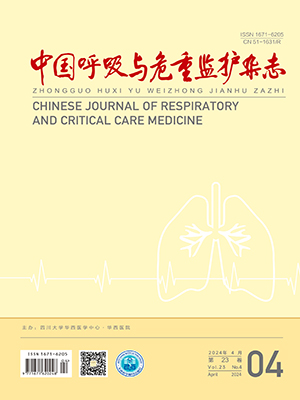| 1. |
Wang F, Nie JY, Wang HL, et al. Characteristics of peripheral lymphocyte subset alteration in 2019-nCoV pneumonia. J Infect Dis, 2020, 221(11): 1762-1769.
|
| 2. |
向天新, 刘家明, 许飞, 等. 江西地区 49 例新型冠状病毒肺炎患者临床特征分析. 中国呼吸与危重监护杂志, 2020, 19(2): 154-160.
|
| 3. |
国家卫生健康委办公厅, 国家中医药管理局办公室. 《新型冠状病毒肺炎诊疗方案 (试行第八版)》[EB/OL]. http://www.gov.cn/zhengce/zhengceku/2020-08/19/5535757/files/da89edf7cc9244fbb34ecf6c61df40bf.pdf.
|
| 4. |
赵建平, 胡轶, 杜荣辉, 等. 新型冠状病毒肺炎糖皮质激素使用的建议. 中华结核和呼吸杂志, 2020, 43(3): 183-184.
|
| 5. |
国家卫生健康委办公厅, 国家中医药管理局办公室. 《新型冠状病毒感染的肺炎诊疗方案(试行第五版)》[EB/OL]. http://www.nhc.gov.cn/yzygj/s7653p/202002/3b09b894ac9b4204a79db5b8912d4440.shtml.
|
| 6. |
Malik YS, Sircar S, Bhat S, et al. Emerging novel Coronavirus (2019-nCoV) – Current scenario, evolutionary perspective based on genome analysis and recent developments. Vet Q, 2020, 40(1): 68-76.
|
| 7. |
Moore JB, June CH. Cytokine release syndrome in severe COVID-19. Science, 2020, 368(6490): 473-474.
|
| 8. |
Wu ZY, McGoogan JM. Characteristics of and important lessons from the coronavirus disease 2019 (COVID-19) outbreak in China: summary of a report of 72314 cases from the Chinese Center for Disease Control and Prevention. JAMA, 2020, 323(13): 1239-1242.
|
| 9. |
Wu JF, Huang JQ, Zhu GC, et al. Systemic corticosteroids show no benefit in severe and critical COVID-19 patients in Wuhan, China: a retrospective cohort study[J/OL]. medRxiv preprint. https://www.researchgate.net/publication/341392226_Systemic_corticosteroids_show_no_benefit_in_severe_and_critical_COVID-19_patients_in_Wuhan_China_A_retrospective_cohort_study.
|
| 10. |
Clark DR, Jonathan EM, J Kenneth B, et al. Clinical evidence does not support corticosteroid treatment for 2019-nCoV lung injury. Lancet, 2020, 395(10223): 473-475.
|
| 11. |
RECOVERY Collaborative Group, Horby P, Lim WS, Emberson JR, et al. Dexamethasone in Hospitalized Patients with Covid-19. N Engl J Med, 2021, 384(8): 693-704.
|
| 12. |
Zhou YG, Fu BQ, Zheng XH, et al. Pathogenic T cells and inflammatory monocytes incite inflammatory storm in severe COVID-19 patients. Natl Sci Rev, 2020, 7(6): 998-1002.
|
| 13. |
姚小红, 李廷源, 何志承, 等. 新型冠状病毒肺炎(COVID-19)三例遗体多部位穿刺组织病理学研究. 中华病理学杂志, 2020, 49(5): 411-417.
|
| 14. |
Wan S, Yi Q, Fan S, et al. Relationships among lymphocyte subsets, cytokines and the pulmonary inflammation index in coronavirus (COVID-19) infected patients. Br J Haematol, 2020, 189(3): 428-437.
|
| 15. |
Pallotto C, Suardi LR, Sperti S, et al. Increased CD4/CD8 ratio as a risk factor for critical illness in coronavirus disease 2019 (COVID-19): a retrospective multicentre study. Infect Dis (Lond), 2020, 52(9): 675-677.
|
| 16. |
Mathew, D, Giles, JR, Baxter, AE, et al. Deep immune profiling of COVID‐19 patients reveals distinct immunotypes with therapeutic implications. Science, 2020, 369(6508): eabc8511.
|
| 17. |
Meckiff BJ, Ramírez-Suástegui C, Fajardo V, et al. Imbalance of regulatory and cytotoxic SARS-CoV-2-reactive CD4+T cells in COVID-19. Cell, 2020, 183(5): 1340-1353.
|
| 18. |
Xie MM, Fang S, Chen Q, et al. Follicular regulatory T cells inhibit the development of granzyme B-expressing follicular helper T cells. JCI Insight, 2019, 4(16): e128076.
|
| 19. |
陈颖诗, 张旭, 彭治林, 等. 糖皮质激素对体外中央记忆性 CD8+ T 淋巴细胞的诱导分化作用. 中国病理生理杂志, 2018, 34(9): 1666-1671.
|




